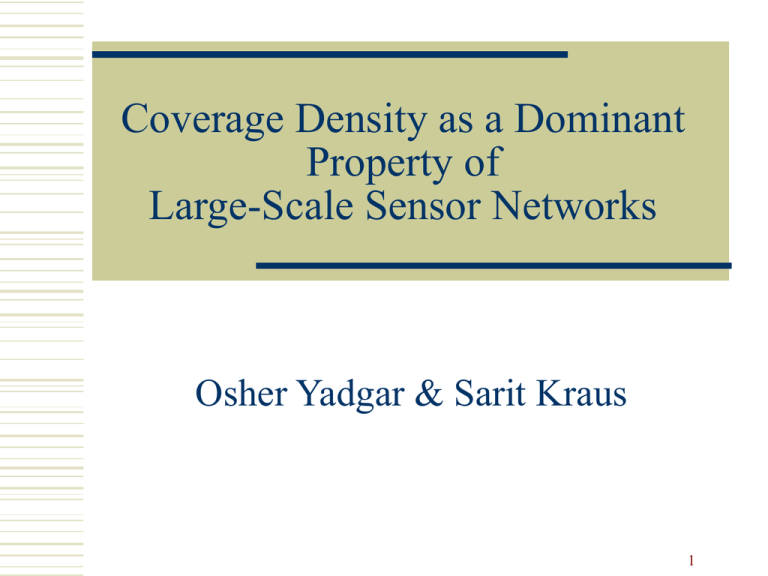Coverage Density as a Dominant Property of Large-Scale Sensor Networks
advertisement

Coverage Density as a Dominant
Property of
Large-Scale Sensor Networks
Osher Yadgar & Sarit Kraus
1
Growing needs of
Large-scale Sensor Networks
i.
Measure the hardness of a given large-scale sensor
network problem,
ii.
Compare a given system to other large-scale sensor
networks in order to extract a suitable solution,
iii. Predict the performance of the solution, and
iv. Derive the value of each system property from the desired
performance of the solution, the problem constraints, and
the user's preferences.
2
Large-scale Agent Systems ?
i.
ii.
iii.
iv.
Thousands of agents ? (Ogston 03, Turner & Jennings 00, …)
Hundreds of agents ? (Ortiz 04, Scerri 04, …)
Dozens of agents ? (Bult 04, …)
Sensor coverage ? (Gage 92, Batalin 02, …)
Coverage Density:
What is the context ? What is the problem space ?
Tradeoffs: time, money, accuracy, survivorability, etc.
3
Coverage Density intuition
Coverage Density defines the time needed to cover the problem
space.
There may be an overlap of agent coverage such that, for example,
a value of 100% Coverage Density does not reflect coverage of all
the controlled area.
Given a limited budget, the system designer should consider
whether to use many cheap sensors or a small number of expensive
sensors.
4
Definition of the Coverage Density
A iN ai whereas N {0,1,..., n 1}
i.
Let A be a set of n agents such that
ii.
Let wa (t ) be the area covered by the sensor of agent ai at a given
time t. The agent may detect objects in this area at time t.
i
iii. Let agent coverage wai be the average area covered by the
sensor of agent ai such that w w (t ) dt .
ai
dt
ai
iv. Let total coverage wA be the average area covered by the sensors of
all the agents such that w w .
n 1
A
ai
0
v.
Let Z be the size of the controlled area.
vi.
Coverage Density is the total coverage divided by the size of the
wA
controlled area such that
.
Z
5
Using the Coverage Density
Environment: a large number of real-time tasks/objects and a
large number of mobile agents in a given geographical area.
Main issues:
Resource management in a large scale environment.
How the agents should be distributed over the area?
How agents should process local information, derived from
possibly noisy sensors, to provide a partial solution?
How partial solutions should be integrated into global
solution?
6
ANTS (Autonomous Negotiating
Teams) related challenge
Environment: Targets and Doppler sensors.
Goal: Form an information map of targets in a
controlled area as a function of time.
Large scale environment
Mobility
7
Challenges
Large scale environment;
Mobile sensor Dopplers;
Real time response;
No clock synchronization;
No close cooperation between the sensors;
Limit the information exchange;
Fault tolerant;
8
Doppler sensors’ properties
A radar is based on the Doppler effect with a wide
beam of 120 degrees.
Provides information only about an arc that the
detected target may be located on and the velocity
towards the sensor (radial velocity)
A single Doppler measurement cannot be used to
establish the exact velocity
Intersection method
9
10
Organizational Structure
Hierarchic structure of groups based on
geographical areas; the base level consists of the
sensor Dopplers.
Each level controls the level below it. It
processes the information obtained from the level
below it
forms an estimation of the information map of its zone
reports to it group leader.
11
Hierarchy Example
Entities
Data Structures
Sampler agent
Group Leader agent
Capsule
InfoMap
Goal
Generate a map of targets
as a function of time.
12
Hierarchy of Group Leaders
Level 4: 1 Zone Group Leader
Level 3: 4 Zone Group Leaders
Level 2: 16 Zone Group Leaders
Level 1: 64 Sampler Group Leaders
13
Simulation environment
150 computers X 4 months = 50 years of CPU
Z= 400,000,000 square meters.
There are 5,000 Sampling and 85 Group Leader agents.
Each Doppler sensor has initial random location and
velocity that is up to 50 kilometers per hour.
Range of interaction: 50 meters.
Sensing time: 10 seconds.
Moving time: 5 seconds.
1.64%
14
Simulation environment
At any given time, there are 1,000 targets in the area. Each
target had an initial random location on the border and an
initial random velocity, with a speed limit of 50 kilometers per
hour (13.9 meters per second).
Targets leave the area when reaching the boundaries of the
zone. Each target that leaves the area causes a new target to
appear at a new location on the border.
A target stays a random time period in the area.
For 7 simulated days total of 13,635 targets.
15
16
17
Conclusions
Coverage Density defines the time needed to cover an area
equal to the size of the controlled zone.
We have shown that there is a strong correlation between the
Coverage Density of a system and its behavior.
We introduced a way to achieve the same system results
with different preferences.
As a result, a system designer may find it easier to achieve a
certain level of system performance under given specific
constraints, such as budget limits.
18





